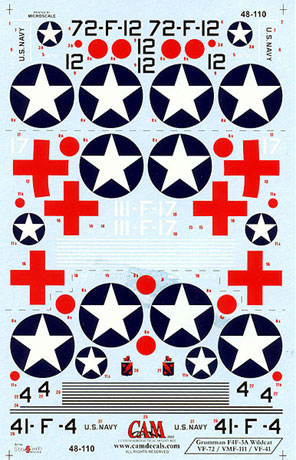|
Battlin' Wildcats

CAM Decals
S u m m a r y
|
| Catalogue
Number and Description: |
48-110 Battlin’ Wildcats
(Grumman F4F-3A Wildcat) |
| Scale: |
1/48 |
| Contents and Media: |
1 decal sheet, one
instruction sheet and one stiff cardboard colour header. |
| Price: |
USD$9.00 |
| Review Type: |
FirstLook |
| Advantages: |
Different and colourful
schemes for Wildcats including yellow wing and wargame marking
options; brave choice of -3A variant; good instructions |
| Disadvantages: |
No F4F-3A available straight
from the box in 1/48 scale |
| Recommendation: |
Recommended |
Reviewed by Rodger Kelly

HyperScale is proudly sponsored by
Squadron
This sheet represents a change of era for CAM Decals. Previously,
they have concentrated on manufacturing decal sheets for more
contemporary aircraft.
This sheet provides markings for three pre-war F-4F-3 Wildcats, two in
the much-loved “yellow wing” markings and one in the immediate pre-war
toned down scheme.
 The
first aircraft is Bureau No 1876 from VF-72 when based on the USS Wasp
in February 1941. It is painted in overall aluminium with
orange-yellow upper wings and gloss black vertical and horizontal
stabilizers and lower cowling. The modeller has to paint the diagonal
wing bands in gloss black and edge them with the supplied white
stripes. Ouch! There is a disaster waiting to happen. I would have
preferred to have seen it the other way round – paint the stripe on in
white and then apply a thicker black decal down the centre. The
first aircraft is Bureau No 1876 from VF-72 when based on the USS Wasp
in February 1941. It is painted in overall aluminium with
orange-yellow upper wings and gloss black vertical and horizontal
stabilizers and lower cowling. The modeller has to paint the diagonal
wing bands in gloss black and edge them with the supplied white
stripes. Ouch! There is a disaster waiting to happen. I would have
preferred to have seen it the other way round – paint the stripe on in
white and then apply a thicker black decal down the centre.
The second aircraft is a USMC one, Bureau No 3923, from VMF-111 and it
is painted in overall light grey with Wargames red crosses painted on
both sides of the fuselage and the tops and bottoms of the wings. The
fuselage red crosses have been manufactured to make allowances for the
curved sides of the fuselage – a nice touch.
The final aircraft is Bureau No 1650 from VF- 41 whilst it was aboard
the USS Ranger in 1941 and it is painted in same scheme as the first
aircraft with the exceptions that the tail surfaces are in Willow
Green and the entire cowling front is white with a thin black band.
The fuselage also sports a white band edged in black. This time the
modeller paints the wing and fuselage bands in white and adds the thin
black edging with the supplied black decal! Hmmm?
The decals are printed by Microscale so you know that they are going
to work for you. The printing is excellent and is so good that you can
actually read the tiny Bureau Nos (decal Number 14 on the VMFA-111
option) under strong magnification!
The instruction sheet is the ubiquitous A-4 sized sheet with detailed
drawings for each subject to show the camouflage scheme and decal
placement as well as painting notes that identify the colours by FS
numbers, not the ANA colours. This last point is note worthy as it
allows the novice USN modeller to simply select the right colour by
matching the FS numbers and not having to scratch around to convert
the correct ANA numbers to FS numbers. The instruction sheet states
that the recommended kit is the Revell F4F-4 converted to F4F-3
standard. Perhaps they mean the old Monogram one.
Packaging is in the tried and true Zip-loc bag with a stiff cardboard
header, simple and effective.
Overall, this is an excellent effort. It is also a courageous move by
a large company as no kit of the -3 exists off the shelf. You can
convert the Tamiya -4 but the conversion is not really for the feint
hearted. If you really want to do it there are various resin
conversions available and you can read about them on Scott Van Aken’s
Modelling Madness website:
http://m2reviews.cnsi.net/kitindex/kitindexf.htm
The decolourisation on the image of the decal sheet is not the
fault of the manufacturer. Unfortunately, it was a victim of a spot of
water splashed on it whilst I was wet-sanding a model at my desk!
Recommended.
Thanks to CAM Decals
for the review sample.
CAM Decals are available online
from their website at http://www.camdecals.com
CAM Decals 59 page 2002 color
catalog of decals and resin parts is also
now available through the CAM Decals website
Review Copyright © 2002 by
Rodger Kelly
This Page Created on 10 September, 2002
Last updated
22 July, 2003
Back to
HyperScale Main Page Back to Reviews Page |
Home | What's
New | Features
| Gallery |
Reviews | Reference
| Forum
| Search